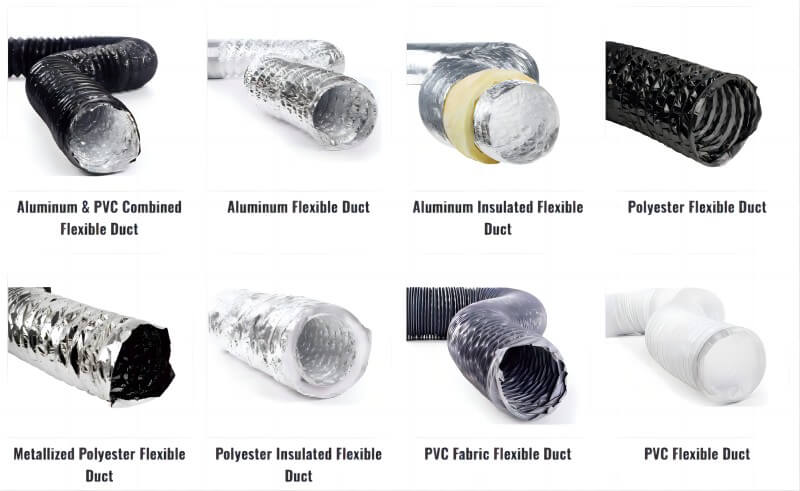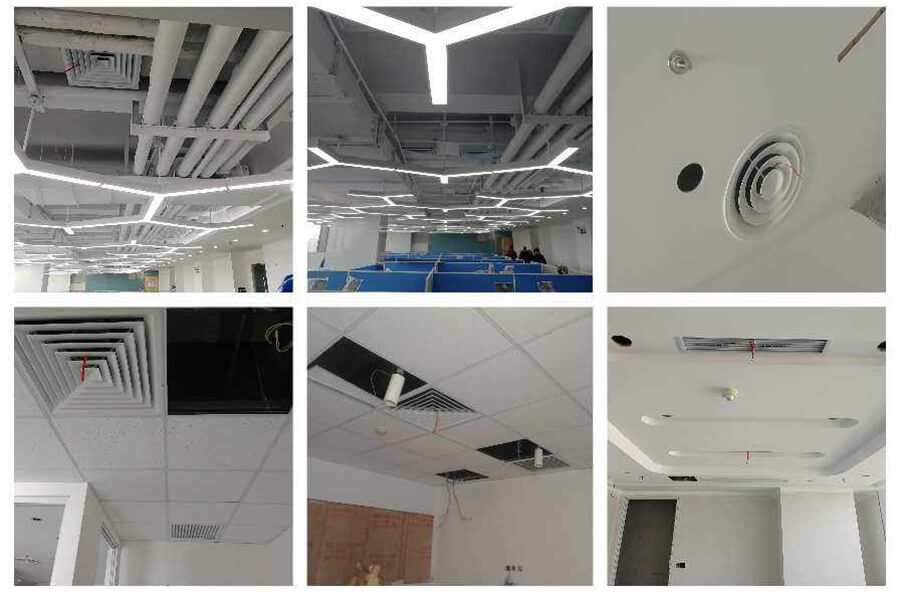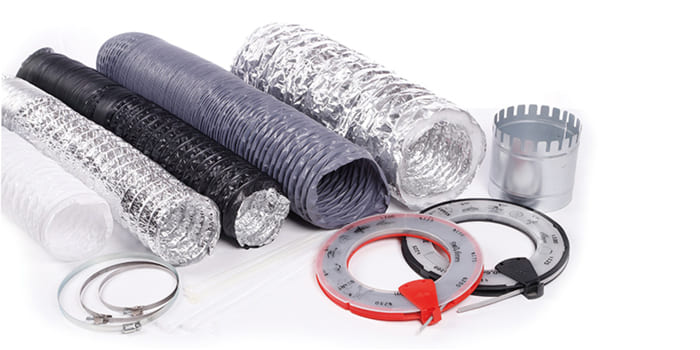At its core, ductwork is the network of tubes that transport air from your HVAC system throughout your home or building. But not all ducts are created equal. They can vary significantly in material, size, and shape, each type serving different needs and spaces. The most common materials include sheet metal, fiberglass duct board, and flexible duct. The choice of material can affect the durability, cost, and efficiency of the air distribution system.
Design Objectives for Optimal Performance
Effective duct design aims to achieve several key objectives:
- Efficient Air Distribution: Ensuring that air is delivered to every intended space in an efficient manner.
- Noise Reduction: Minimizing noise for a quieter, more comfortable environment.
- Energy Conservation: Designing the system to minimize energy loss, thereby reducing heating and cooling costs.
Understanding these objectives is crucial for anyone involved in the design, installation, or maintenance of HVAC systems.
Common Materials and Their Applications
Let’s delve a bit deeper into the materials used for ductwork:
- Sheet Metal: Highly durable and resistant to mold and the growth of bacteria; it’s the most common material for ducts.
- Fiberglass Duct Board: Offers excellent thermal insulation and sound absorption qualities but requires careful handling to maintain indoor air quality.
- Flexible Duct: Useful for tricky spaces where traditional ducts can’t fit; however, they must be installed properly to avoid issues with airflow and efficiency.
Each material has its specific applications and benefits, and the choice depends on various factors, including the layout of the space, budget, and specific system requirements.

Ductwork Design Standards and Codes
Navigating the landscape of ductwork design standards and codes is essential for anyone involved in the planning, installation, or renovation of HVAC systems. These standards and codes ensure that ductwork is designed to provide optimal performance, safety, and energy efficiency. Understanding and adhering to these guidelines is not just about compliance; it’s about ensuring the longevity and efficiency of your HVAC system.
Adhering to Industry Standards
Several organizations set the benchmarks for HVAC design and installation practices. Among them, the American Society of Heating, Refrigerating and Air-Conditioning Engineers (ASHRAE) and the Air Conditioning Contractors of America (ACCA) are leading voices. They provide comprehensive guides and standards, such as:
- ASHRAE Standards: Focus on system design for proper indoor air quality, energy efficiency, and environmental impact.
- ACCA’s Manual D: The definitive guide on ductwork design, detailing how to size ducts for efficient, balanced airflow.
Familiarity with these standards is crucial for creating HVAC systems that are efficient, reliable, and conducive to healthy indoor environments.
Local Building Codes and Regulations
Local building codes and regulations can vary significantly from one region to another. These codes often incorporate or reference industry standards, but they can also include additional requirements specific to the local climate, construction practices, or energy efficiency goals. It’s essential to:
- Check Local Regulations: Always consult your local building department for the most current ductwork installation codes before starting a project.
- Permitting Process: Understand that part of complying with local codes often involves obtaining the necessary permits and inspections for HVAC work.
Energy Efficiency Requirements
Energy conservation is a key focus of both national and international codes. The International Energy Conservation Code (IECC) sets minimum energy efficiency standards for new and renovated buildings, including aspects of HVAC design and ductwork. These standards help ensure that buildings are constructed to minimize energy consumption, which not only reduces environmental impact but also lowers energy costs for the occupants. Key points include:
- Insulation and Sealing: Requirements for duct insulation and sealing to prevent energy loss.
- System Testing: Mandates on testing HVAC systems, including ductwork, for efficiency and air leakage.
Adhering to these energy efficiency requirements is not just good practice; it’s an investment in the building’s future sustainability and operational costs.
Evaluating Ductwork Layout and Sizing
The layout and sizing of your ductwork are pivotal for the overall performance of your HVAC system. Correct ductwork design ensures efficient air distribution, optimal energy use, and enhanced comfort levels throughout the space. This section will guide you through the critical aspects of evaluating your ductwork’s layout and sizing.
Understanding Manual D: The Standard for Ductwork Sizing
The Air Conditioning Contractors of America (ACCA) provides Manual D, a comprehensive standard for residential duct systems. This guide is essential for determining the correct sizes and layout of ducts to ensure balanced airflow, proper ventilation, and maximum comfort. Key considerations include:
- Room-by-Room Load Calculations: Start with accurate load calculations for each room to determine the required airflow.
- Duct Sizing: Use the Manual D calculations to size ducts appropriately, ensuring they can deliver the necessary air volume efficiently.
Layout Considerations for Efficient Airflow
Designing an efficient ductwork layout involves more than just connecting supply and return vents. It requires strategic planning to ensure air is distributed evenly and returns to the HVAC system without creating pressure imbalances. Tips for effective layout design include:
- Minimizing Length and Turns: Shorter duct runs with fewer turns reduce resistance and improve airflow efficiency.
- Strategic Vent Placement: Ensure supply vents and return grilles are placed to optimize air distribution and comfort within each space.
Sizing for Efficiency
Proper duct sizing is crucial for achieving energy efficiency and comfort. Oversized ducts can lead to low air velocity, poor air distribution, and increased energy usage, while undersized ducts can cause higher velocity, noise, and system strain. Remember:
- Balance is Key: Aim for a balance that supports efficient airflow minimizes energy loss and ensures quiet operation.
- Consult a Professional: When in doubt, consulting with a professional HVAC designer or using advanced design software can help verify your ductwork sizing and layout for optimal performance.
Inspecting Ductwork for Quality and Performance
Regular inspections of your ductwork can prevent issues that affect your HVAC system’s efficiency and the comfort of your home. Here’s how to conduct these inspections focusing on quality and performance.
Insulation and Sealing
Effective duct insulation and sealing are essential for maintaining energy efficiency and preventing air loss. Check for:
- Adequate Insulation: Ensure ducts, especially those in unconditioned spaces, are well-insulated to prevent heat loss or gain.
- Seal Leaks: Use mastic sealant or metal tape (not duct tape) to seal any leaks or gaps in the ductwork.
Airflow and Pressure Testing
Testing for airflow and pressure can reveal hidden leaks and imbalances in your duct system. Consider:
- Hiring Professionals: They can perform detailed tests, such as a duct blaster test, to measure air leakage and identify leaks that need sealing.
- Monitoring Performance: Regularly check your HVAC system’s performance. Unusual noise, uneven heating or cooling, and increased energy bills can indicate ductwork issues.
Troubleshooting Common Issues
Be on the lookout for common ductwork problems, such as:
- Noise: Rattling, whistling, or banging sounds can indicate loose fittings, high air velocity, or other issues.
- Uneven Heating or Cooling: This may suggest blocked vents, leaks, or improperly sized ducts.

Professional Assessment and Verification
While a keen eye and a basic understanding can take you far in ensuring your ductwork is up to par, there are instances where the expertise of a professional HVAC technician becomes indispensable. Professional assessment and verification offer peace of mind and ensure that your system meets all required standards for efficiency, safety, and performance.
Recognizing the Need for an Expert
Certain situations call for professional intervention, such as:
- Complex Layouts: Intricate or large-scale duct systems often require a nuanced approach that only experienced professionals can provide.
- Performance Issues: If you’ve noticed persistent problems with heating, cooling, or airflow, an expert can diagnose and resolve issues that might not be apparent to the untrained eye.
- New Installations or Major Renovations: These are critical moments to ensure everything is done right from the start, adhering to all relevant codes and standards.
Benefits of Professional Verification
A professional HVAC technician can offer:
- Comprehensive Inspections: Using advanced tools and techniques to assess your ductwork’s condition, layout, and sizing accurately.
- Expert Recommendations: Offering tailored advice on improving your system’s efficiency, from sealing leaks to upgrading insulation.
- Peace of Mind: Ensuring your ductwork is correctly designed and installed, contributes to your HVAC system’s longevity and performance.
Certification and Documentation
Having your ductwork assessed and verified by a professional can also provide valuable documentation, including:
- Certification of Compliance: Proving your system meets local codes and energy efficiency standards, which can be beneficial for warranty purposes, resale value, and more.
- Detailed Reports: Outlining the condition of your ductwork, any issues found, and recommendations for improvement or repairs.
Conclusion
The ductwork of your HVAC system plays a critical role in maintaining the comfort, air quality, and energy efficiency of your space. Through careful design, regular inspections, and adherence to standards and codes, you can ensure your ductwork contributes positively to your HVAC system’s overall performance. Remember, while many aspects of ductwork maintenance can be handled with a DIY approach, recognizing when to call in the professionals is key to addressing complex issues and verifying your system operates at its best.
If you want to know more, please click below:
- Grilles, Registers & Diffusers – The Ultimate Guide
- HVAC Linear Slot Diffusers – The Ultimate Guide
- HVAC Egg Crate Diffuser – The Ultimate Guide
- HVAC Jet Nozzle Diffuser – The Ultimate Guide
- HVAC Linear Bar Grilles – The Ultimate Guide
- HVAC Air Swirl Diffusers – The Ultimate Guide
- HVAC Round Ceiling Diffusers – The Ultimate Guide
- Round Ceiling Diffusers – The Ultimate Guide
- Exhaust Air Louver – The Ultimate Guide
- HVAC Registers – The Ultimate Guide


